- Growing Peaches: A Comprehensive Guide
- Introduction
- Getting Started
- Seed Germination
- Transplanting and Care
- Harvesting
- Conclusion
- Choosing the Right Peach Varieties
- 1. Climate
- 2. Ripening Time
- 3. Flavor and Texture
- 4. Disease Resistance
- 5. Pollination
- 6. Tree Size
- Preparing the Soil for Growing Peaches
- 1. Selecting the Site
- 2. Clearing the Area
- 3. Testing the Soil
- 4. Improving Drainage
- 5. Adding Organic Matter
- 6. Mulching the Soil
- 7. Watering the Soil
- Planting Peach Seeds: Step-by-Step Instructions
- Caring for Young Peach Trees
- 1. Planting the Tree
- 2. Watering
- 3. Mulching
- 4. Fertilizing
- 5. Pruning
- 6. Pest and Disease Control
- 7. Winter Protection
- 8. Training and Support
- 9. Harvesting
- Pruning and Training Peach Trees
- Why Prune and Train Peach Trees?
- When to Prune Peach Trees
- How to Prune Peach Trees
- Training Peach Trees
- Peach Tree Pests and Diseases: Prevention and Treatment
- Pests
- Diseases
- Harvesting and Storing Fresh Peaches
- Harvesting Peaches
- Storing Peaches
- Peach Recipes: Delicious Ways to Enjoy Your Harvest
- Peach Cobbler
- Peach Smoothie
- Grilled Peach Salad
- Peach Salsa
- Peach Pie
- Conclusion
- Question-answer:
- Can I grow peaches from seed?
- How long does it take for a peach tree to grow from seed?
- What is the best time to plant peach seeds?
- Do peach trees need a lot of sunlight?
- How often should I water peach trees?
- When is the best time to harvest peaches?
- Video: How to Plant & Grow a Peach Tree from a Pit & Seed
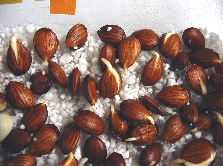
Are you a peach enthusiast? Do you dream of biting into a juicy, perfectly ripe peach that you grew with your own two hands? Well, you’re in luck! In this article, we will guide you through the process of growing peaches from seed to harvest. Whether you have a large garden or just a small balcony, with the right knowledge and care, you can enjoy the sweet taste of homegrown peaches.
Step 1: Choosing the right variety
The first step in growing peaches is selecting the right variety for your climate and space. Peaches come in many different varieties, each with its own unique flavor and growth characteristics. Some varieties are better suited for colder climates, while others thrive in warmer regions. Take some time to research the different varieties and choose one that is best suited for your specific growing conditions.
Step 2: Starting from seed
Once you have chosen the variety, it’s time to start growing your peach tree from seed. Begin by collecting seeds from a ripe peach. Remove the peach pit and wash away any remaining fruit flesh. Place the pit in a plastic bag with some damp sphagnum moss or paper towel, and store it in the refrigerator for about 8 weeks. This process, known as cold stratification, mimics the natural winter conditions that peach seeds need to germinate.
Step 3: Caring for your peach tree
After the cold stratification period is complete, it’s time to plant your peach seed. Choose a sunny spot in your garden or prepare a large container if you’re growing the peach tree in a limited space. Ensure that the soil is well-draining and amend it with organic matter to promote healthy root growth. Water your peach tree regularly, especially during dry periods, and provide it with a balanced fertilizer to ensure optimal growth.
Step 4: Harvesting and enjoying your peaches
After a few years of nurturing and caring for your peach tree, the moment you’ve been waiting for finally arrives – it’s time to harvest your peaches! The fruit is ready to pick when it easily separates from the branch with a gentle twist. Be sure to handle the peaches gently to avoid bruising. Once harvested, allow them to fully ripen at room temperature before enjoying the sweet, juicy taste of your homegrown peaches. It’s a rewarding experience that you won’t soon forget!
Remember, growing peaches takes time and patience. It may take a few years before your tree starts producing fruit, but the wait is well worth it. So roll up your sleeves, grab your gardening tools, and get ready to embark on the journey of growing your very own peaches!
Growing Peaches: A Comprehensive Guide
Introduction


If you’ve ever wanted to enjoy the sweet, juicy taste of freshly picked peaches from your own backyard, you’re in luck! This comprehensive guide will walk you through the entire process of growing peaches, from seed to harvest. Whether you’re a seasoned gardener or a beginner, you’ll find all the information you need to successfully grow and care for peach trees.
Getting Started
Before you begin planting your peach trees, there are a few important things to consider.
- Climate: Peaches thrive in regions with mild winters and hot summers. They require a certain number of chilling hours (hours below 45°F/7°C) during their dormant period to set fruit.
- Soil: Peaches prefer well-draining soil with a pH level between 6.0 and 7.0. Conduct a soil test to determine if any adjustments need to be made.
- Site Selection: Choose a location that receives full sun for at least 6 hours a day. Avoid low-lying areas that are prone to frost or standing water.
Seed Germination
To grow a peach tree from seed, follow these steps:
- Seed Selection: Choose a ripe and healthy peach. Extract the seed from the flesh and wash off any remaining fruit.
- Seed Preparation: Place the seed in a plastic bag with a moist paper towel. Seal the bag and refrigerate it for 6-8 weeks. This process, called cold stratification, mimics the natural winter dormancy of the seed.
- Planting: Fill a pot with well-draining soil, leaving about an inch of space at the top. Plant the seed about an inch deep and water thoroughly. Place the pot in a warm and sunny location.
- Growth and Care: Keep the soil consistently moist but not waterlogged. As the seedling grows, provide it with ample sunlight and periodic fertilization.
Transplanting and Care
Once your peach seedling has grown to a size of 6-10 inches, it’s time to transplant it into the ground. Follow these steps:
- Preparation: Dig a hole that is slightly larger than the root ball of the seedling. Ensure that the soil is well-draining and loosened.
- Transplanting: Gently remove the seedling from its pot, taking care not to damage the roots. Place the root ball into the hole and backfill with soil. Water thoroughly.
- Care: Mulch around the base of the tree to conserve moisture and suppress weeds. Prune any damaged or crossing branches, and fertilize in the early spring and late fall.
Harvesting
Peaches are ready to harvest when they have reached their full color, are slightly soft to the touch, and easily separate from the tree with a gentle twist.
It’s important to harvest peaches carefully to avoid bruising or damaging the fruit. Use both hands to gently twist and pull the peach off the stem. Avoid pulling too hard, as this can cause the branch to break.
Conclusion
By following this comprehensive guide, you’ll be able to successfully grow your own delicious peaches from seed to harvest. Enjoy the fruits of your labor and share the bounty with friends and family!
Choosing the Right Peach Varieties
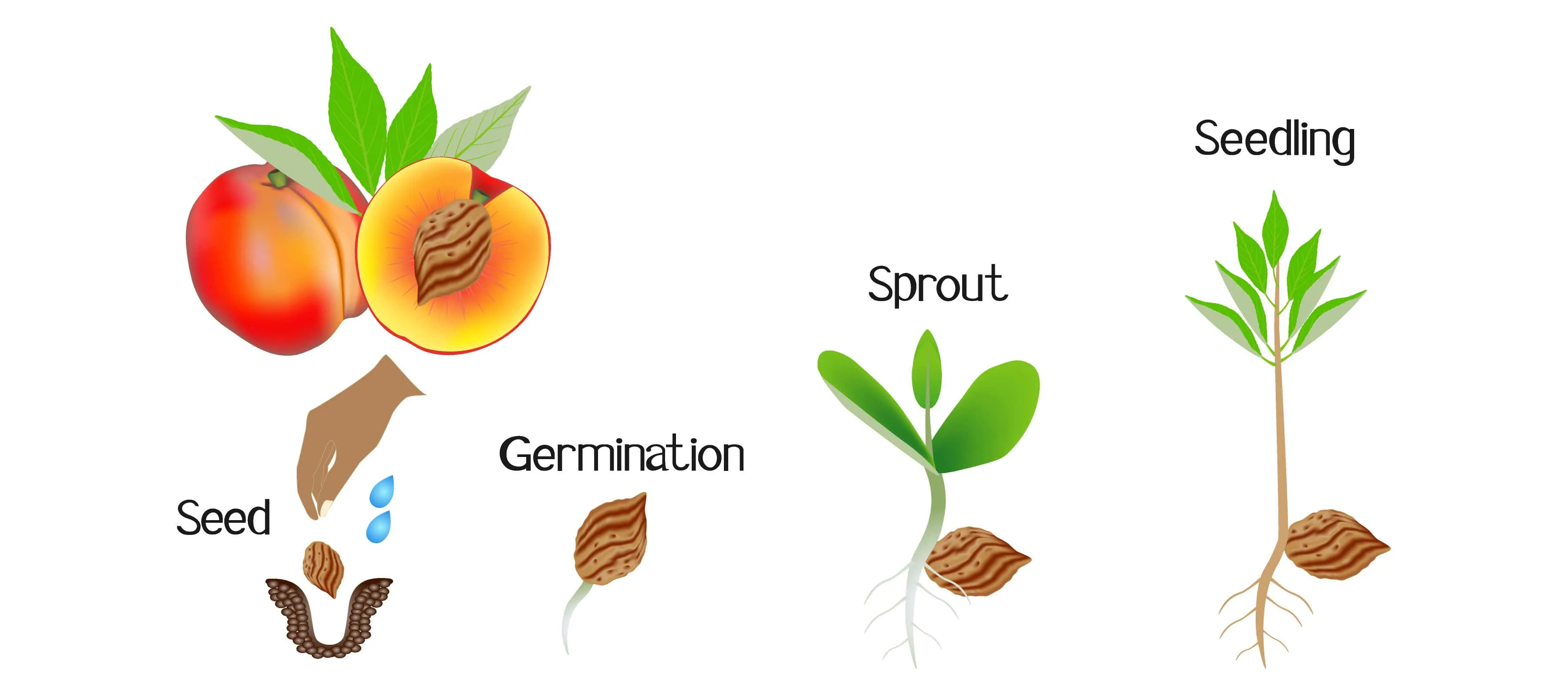

When it comes to growing peaches, choosing the right variety is crucial for a successful harvest. There are many different peach varieties available, each with their own unique characteristics and growing requirements. Here are some factors to consider when selecting the right peach variety for your garden:
1. Climate
Peaches thrive in warm climates, so it’s important to choose a variety that is suitable for your specific climate. Some peach varieties are better suited for hot and dry climates, while others can tolerate cooler temperatures. Research the climate requirements of different peach varieties to ensure they will thrive in your area.
2. Ripening Time
Different peach varieties ripen at different times throughout the growing season. It’s a good idea to choose a mix of early, mid-season, and late ripening varieties to enjoy fresh peaches throughout the summer. This will also help spread out the harvest and prevent a large influx of ripe peaches all at once.
3. Flavor and Texture
Peaches come in a wide range of flavors and textures. Some varieties are incredibly sweet and juicy, while others have a more tart or tangy taste. Consider your personal preferences and intended use for the peaches when choosing a variety. If you plan to eat them fresh, look for sweeter varieties. If you want to use them for baking or canning, varieties with a firmer texture may be more suitable.
4. Disease Resistance
Peach trees are susceptible to various diseases, such as peach leaf curl and brown rot. Choosing disease-resistant varieties can help minimize the risk of these issues and reduce the need for chemical treatments. Look for varieties that are known for their disease resistance and suitability for your region.
5. Pollination
Some peach varieties are self-fertile, meaning they can produce fruit on their own without the need for a pollinator. Others require cross-pollination with a compatible variety to set fruit. If you have limited space or are only planning to grow one peach tree, choose a self-fertile variety. Otherwise, make sure to select two or more varieties that can cross-pollinate each other.
6. Tree Size
Peach trees come in a range of sizes, from dwarf varieties that can be grown in containers to larger trees suitable for spacious gardens. Consider the available space in your garden and the level of maintenance you are willing to put into pruning and caring for the tree. Dwarf or semi-dwarf varieties may be more suitable for small spaces and easier to maintain.
By considering these factors and doing some research, you can choose the right peach varieties for your garden and enjoy a bountiful harvest of delicious peaches. Remember to provide adequate care and maintenance to ensure the best possible growth and fruit production.
Preparing the Soil for Growing Peaches
Growing peaches successfully starts with preparing the right soil. Peaches prefer well-draining soil that is rich in organic matter. Follow these steps to prepare the soil for growing healthy and productive peach trees:
1. Selecting the Site
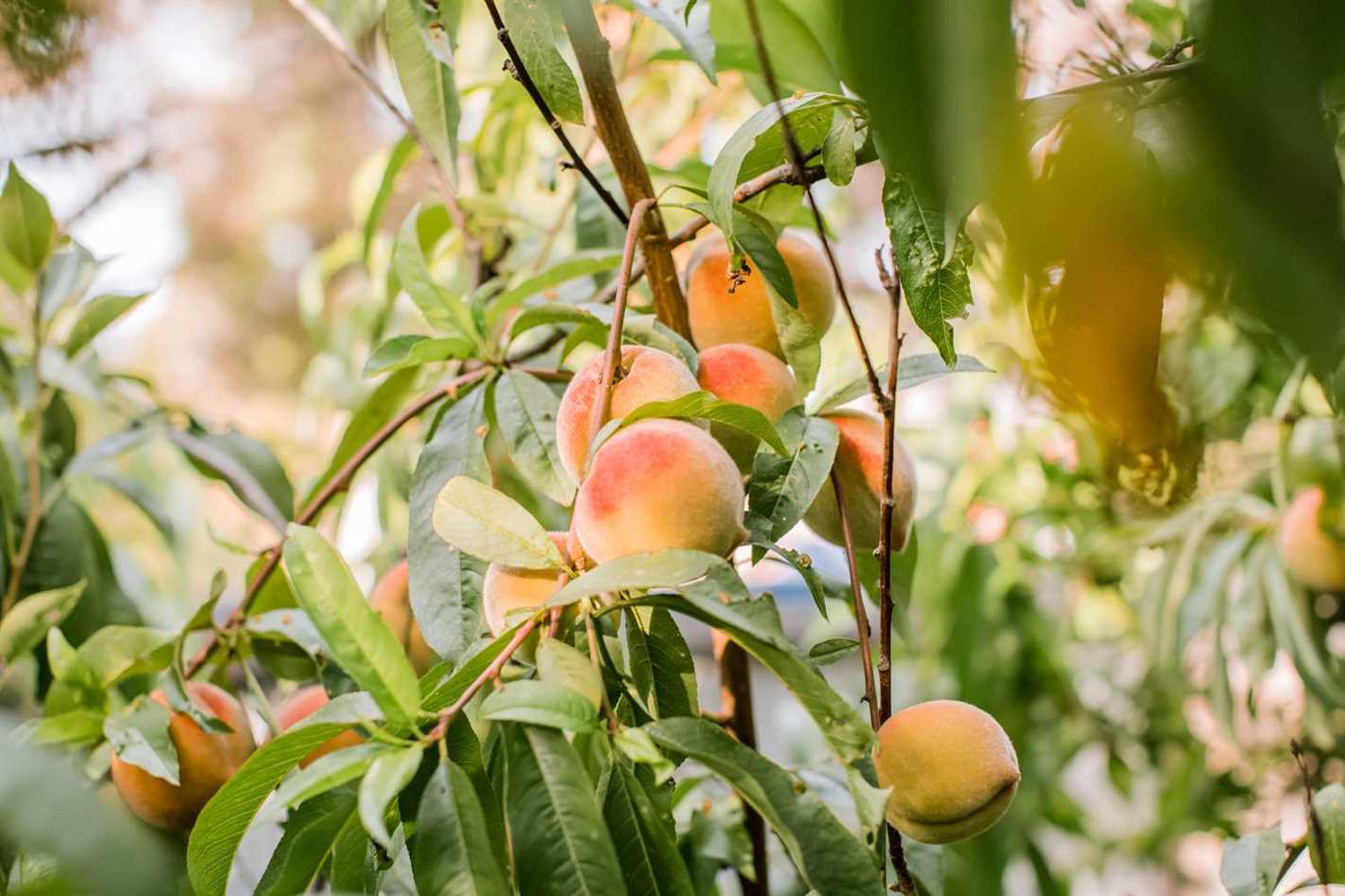

Choose a location that receives full sunlight for at least 6 to 8 hours a day. Peaches thrive in warm climates and require direct sun exposure to develop their fruit. Additionally, select a site with good air circulation to prevent fungal diseases.
2. Clearing the Area
Remove any weeds, grass, or debris from the selected area. Clearing the ground will ensure that the peaches have access to all the nutrients and water in the soil.
3. Testing the Soil
Perform a soil test to assess its pH level and nutrient content. Peaches prefer slightly acidic soil with a pH range of 6.0 to 6.5. If the pH is too high or too low, you can adjust it by adding the necessary amendments.
4. Improving Drainage
Peaches require well-draining soil to avoid waterlogged conditions, which can lead to root rot. If your soil has poor drainage, consider amending it by adding organic matter such as compost, peat moss, or aged manure.
5. Adding Organic Matter
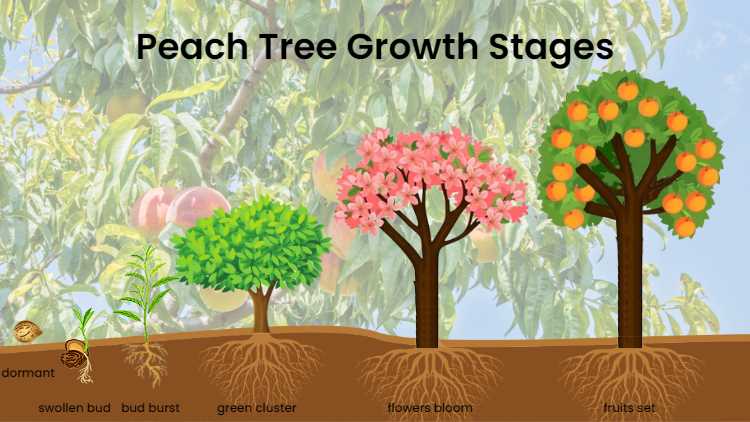

Incorporate organic matter into the soil to improve its fertility and structure. Spread a layer of compost or well-rotted manure over the top of the soil and work it in using a garden fork or tiller. This will provide the peaches with essential nutrients and promote healthy root development.
6. Mulching the Soil
Apply a layer of mulch around the base of the peach tree to conserve moisture, suppress weeds, and regulate soil temperatures. Organic mulches, such as wood chips or straw, are ideal for peaches. Ensure that the mulch is 2 to 3 inches thick and spread it out in a 2 to 3-foot radius around the tree, keeping it a few inches away from the trunk.
7. Watering the Soil
Before planting the peach tree, thoroughly water the soil to ensure that it is moist. This will help the tree establish its roots and settle into its new environment.
By following these steps to prepare the soil, you will create an optimal growing environment for your peach trees, setting the stage for a bountiful harvest.
Planting Peach Seeds: Step-by-Step Instructions
Planting peach seeds is a great way to grow your own peach tree and enjoy delicious homegrown peaches. Follow these step-by-step instructions to successfully plant peach seeds:
- Selecting the Seeds: Choose fresh, ripe peaches to obtain the seeds. Look for peaches that are firm but slightly soft to touch.
- Removing the Seeds: Cut the peaches in half and carefully remove the pit (seed) from the center. Gently wash the seeds to remove any flesh or pulp.
- Preparing the Seeds: Fill a bowl with warm water and soak the seeds for 24 hours. This will help soften the seed coat and improve germination.
- Chilling the Seeds: After soaking for 24 hours, transfer the seeds to a moist paper towel and seal them in a plastic bag. Place the bag in the refrigerator and let the seeds undergo a cold stratification process for about 8 to 10 weeks.
- Testing the Seeds: After the chilling period, check the seeds for viability by conducting a germination test. Place the seeds in a damp paper towel and keep them in a warm location. If the seeds sprout within a couple of weeks, they are viable and ready for planting.
- Planting the Seeds: Fill small pots or seed trays with well-draining potting soil. Make a small hole in each container and plant one seed in each hole. Gently cover the seeds with soil and water them thoroughly.
- Caring for the Seedlings: Keep the pots or trays in a warm and sunny location, such as a windowsill. Ensure the soil remains moist but not waterlogged. After the seedlings have grown a few inches tall, transplant them into larger containers or directly into the ground.
- Maintaining the Peach Tree: Provide regular watering, fertilizer, and proper pruning to help the peach tree thrive and produce healthy fruits. Protect the tree from pests and diseases by monitoring and taking appropriate preventive measures.
- Harvesting Peaches: Depending on the variety and growing conditions, your peach tree will start producing peaches in about 2 to 4 years. Harvest the peaches when they are fully ripe and enjoy the sweet taste of your homegrown fruit!
With patience and proper care, you can successfully grow peach trees from seeds and enjoy the satisfaction of nurturing your own fruit-bearing tree. Happy planting!
Caring for Young Peach Trees
1. Planting the Tree
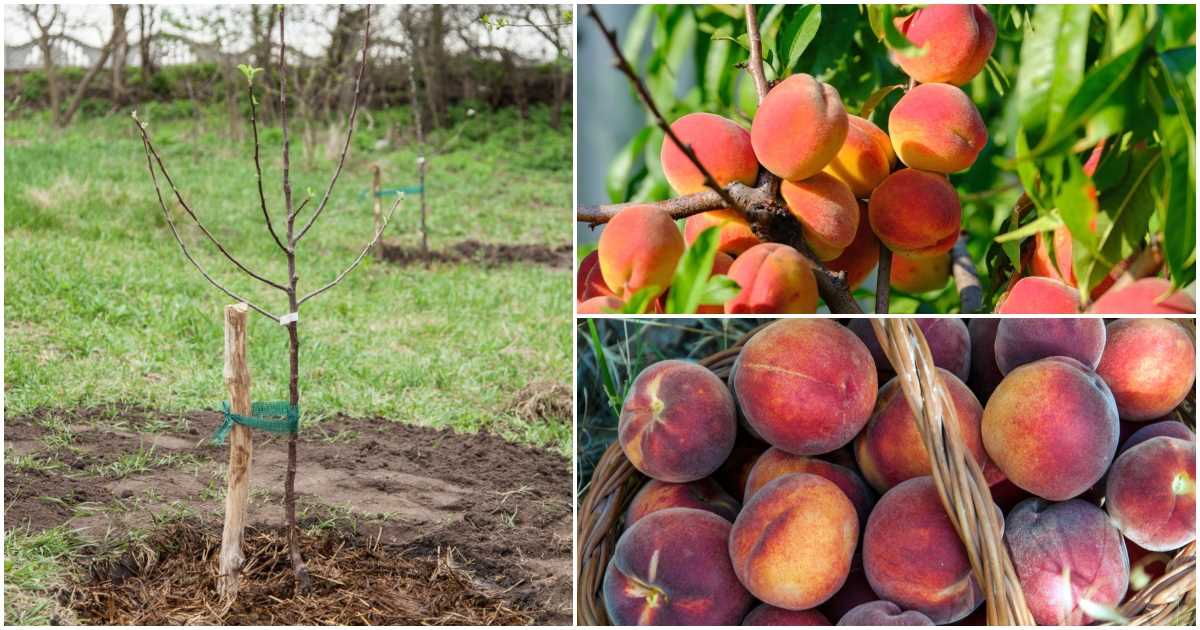

When planting a young peach tree, it’s important to choose a sunny location with well-draining soil. Dig a hole that is wide and deep enough to accommodate the root system of the tree. Place the tree in the hole, making sure the bud union is slightly above ground level. Backfill the hole with soil and firm it gently around the base of the tree.
2. Watering
Water is crucial for the establishment and growth of young peach trees. Provide the newly planted tree with ample water for the first few weeks, ensuring the root zone is consistently moist. After the tree has become established, water deeply and infrequently, allowing the soil to dry out slightly between waterings. Avoid overwatering, as this can lead to root rot and other problems.
3. Mulching
Applying a layer of organic mulch around the base of the tree helps to conserve soil moisture, prevent weed growth, and regulate soil temperature. Use materials such as wood chips, straw, or compost and spread them in a 2-3 inch layer around the tree, taking care to keep the mulch a few inches away from the trunk.
4. Fertilizing
Young peach trees require regular fertilization to support healthy growth. Apply a balanced fertilizer, such as a 10-10-10 formula, in early spring before new growth begins. Follow the manufacturer’s instructions for application rates. Avoid excessive use of nitrogen, as this can lead to vigorous vegetative growth at the expense of fruit production.
5. Pruning
Pruning young peach trees is essential to establish a strong structure and promote fruit production. It’s best to prune in late winter or early spring while the tree is still dormant. Remove any dead or damaged branches, as well as any branches that are crossing or rubbing against each other. Open up the center of the tree to allow for good air circulation and light penetration.
6. Pest and Disease Control
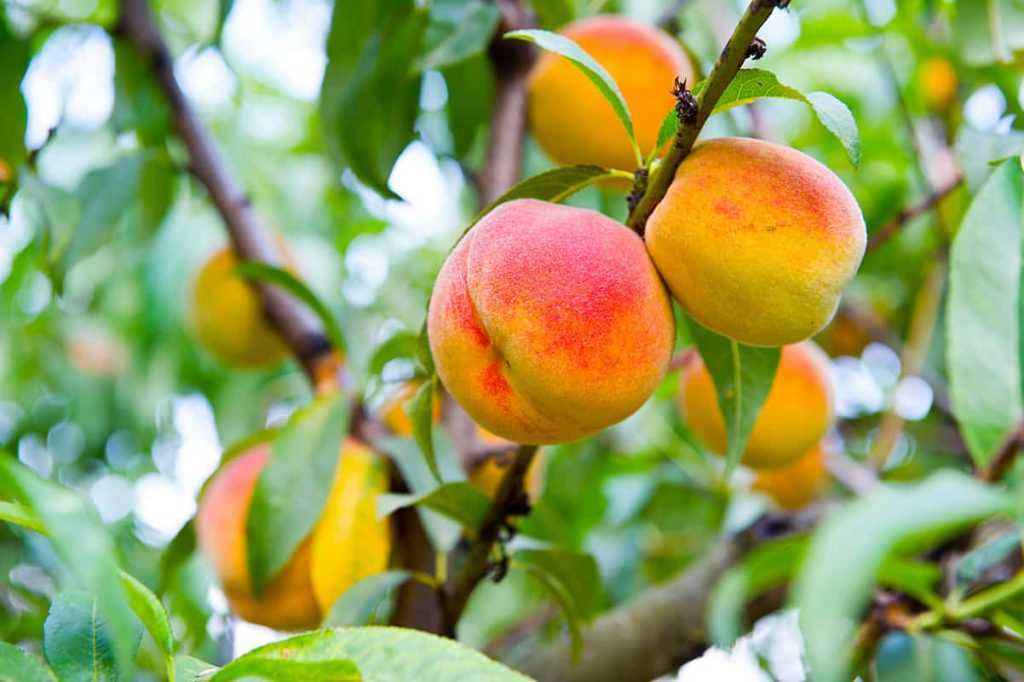

Young peach trees are susceptible to a variety of pests and diseases, including aphids, peach leaf curl, and brown rot. Monitor your tree regularly for signs of infestation or disease, and take appropriate action when necessary. This may include applying insecticidal soap or oil, using fungicides, or practicing cultural controls such as removing infected fruit or pruning affected branches.
7. Winter Protection
Peach trees are susceptible to winter damage, especially in colder climates. Protect young trees from frost by wrapping the trunk with burlap or using tree wraps. Applying a layer of mulch around the base of the tree can also help to insulate the roots. Consider using temporary covers or blankets during periods of extreme cold.
8. Training and Support
As young peach trees grow, it’s important to provide support and training to help them develop a sturdy structure. Use stakes or trellises to support the main trunk and branches, especially in windy areas. Regularly check and adjust the supports as the tree grows. Prune and shape the tree as needed to encourage a balanced shape and prevent overcrowding.
9. Harvesting
While caring for a young peach tree, it’s important to keep in mind that it will take a few years before the tree reaches maturity and starts producing fruit. Typically, it takes about 3-4 years for a peach tree to begin bearing fruit. Once the tree starts producing, harvest the peaches when they are fully ripe. They should easily detach from the branch and have a fragrant aroma.
Pruning and Training Peach Trees
Pruning and training peach trees is essential for maintaining their health and productivity. Proper pruning helps to shape the tree, maintain good airflow, and remove diseased or damaged branches. Training the tree involves guiding its growth in a way that maximizes fruit production and makes harvesting easier.
Why Prune and Train Peach Trees?
Pruning and training peach trees offer several benefits:
- Promotes better airflow: Removing overcrowded branches allows air to circulate more freely through the canopy, reducing the risk of fungal diseases.
- Controls tree size: Pruning helps to manage the size of the tree, making it easier to harvest and care for.
- Increases fruit production: Proper pruning stimulates the growth of new fruiting wood and encourages higher yields.
- Prevents pests and diseases: Regular pruning can prevent the spread of pests and diseases by removing infected branches.
When to Prune Peach Trees
The best time to prune peach trees is in late winter or early spring, before new growth begins. Pruning during this time minimizes stress on the tree and allows wounds to heal quickly.
How to Prune Peach Trees
Here is a step-by-step guide on how to prune peach trees:
- Remove dead and diseased wood: Start by removing any dead, damaged, or diseased branches. This helps prevent the spread of disease and opens up the canopy.
- Thin out overcrowded branches: Identify branches that are growing too closely together and remove the weaker ones. Aim for a well-spaced canopy that allows sunlight to reach all parts of the tree.
- Prune for shape: Peach trees should ideally have an open vase shape, with a central leader and several main scaffold branches. To achieve this, selectively prune branches to create an open framework.
- Manage tree height: If the tree is getting too tall, prune the upper branches to reduce its height. This makes harvesting easier and prevents the tree from becoming top-heavy and prone to breakage.
- Prune suckers: Remove any vigorous, vertical shoots that emerge from below the graft union. These suckers take energy away from fruit production and should be promptly removed.
Training Peach Trees


Training peach trees involves guiding their growth for optimal fruit production. Here are some training techniques:
- Selecting a central leader: Choose a strong, upright branch near the top of the tree to serve as the central leader. This will become the main trunk of the tree.
- Developing scaffold branches: Encourage the growth of several sturdy branches that radiate out from the central leader. These will become the main framework of the tree.
- Prune for an open canopy: Remove any branches that are growing downward or crossing each other. Aim for an open canopy that allows sunlight to reach all parts of the tree.
- Train branches to an outward angle: Use weights or ties to gently bend branches away from the center of the tree. This encourages better fruiting and prevents crowding.
With regular pruning and training, your peach trees will remain healthy and productive for years to come. Remember to use sharp, clean tools and to sterilize them between cuts to prevent the spread of diseases. Happy pruning!
Peach Tree Pests and Diseases: Prevention and Treatment
Pests
Peach trees are susceptible to several common pests that can damage the tree and its fruit. Some of the pests to watch out for include:
- Peach tree borer: These insects lay eggs on the trunk of the tree, which hatch into larvae that bore into the wood. Signs of infestation include gummosis, sawdust-like frass, and wilting branches. To prevent infestation, keep the tree healthy and regularly inspect the trunk for eggs or larvae. Use sticky bands around the trunk to catch adult borers.
- Peach twig borer: These pests attack the twigs of the tree, causing damage to new growth. Signs of infestation include curled and wilted twigs. Prune and destroy infected twigs and use an insecticide to control the population.
- Aphids: These small insects suck the sap from the tree, causing yellowing leaves and stunted growth. Use insecticidal soap or neem oil to control aphid populations.
- Peach tree leaf curl aphid (PTLCA): This aphid specifically targets peach tree leaves, causing them to curl and become distorted. Pruning and destroying infected leaves and using insecticidal soap can help control the aphid population.
- Red spider mites: These pests feed on the undersides of leaves, causing yellow speckles and webs. Regularly spray the tree with water to discourage mites and use insecticidal soap if necessary.
Diseases
Peach trees are also prone to several diseases that can affect their health and fruit production. Some common peach tree diseases include:
- Peach leaf curl: This disease causes the leaves to curl, turn red, and eventually drop. Copper-based sprays can be used in late winter or early spring to prevent leaf curl.
- Peach scab: This disease causes scab-like lesions on the fruit and leaves. Remove and destroy infected plant parts and use a fungicide to control the disease.
- Brown rot: This fungal disease causes fruit rot and blossom blight. Remove and destroy infected fruit and monitor humidity levels to prevent the disease from spreading.
- Leaf spot: This disease causes dark spots on the leaves, leading to defoliation. Prune and remove infected leaves and improve air circulation to prevent leaf spot.
- Crown gall: This bacterial disease causes gall-like growths on the trunk and roots of the tree, leading to overall decline. There is no treatment for crown gall, so prevention is key by using disease-free planting material and maintaining a healthy tree.
| Pests | Treatment |
|---|---|
| Peach tree borer | Inspect trunk regularly, use sticky bands, and remove larvae manually |
| Peach twig borer | Prune and destroy infected twigs, use insecticide |
| Aphids | Use insecticidal soap or neem oil |
| Peach tree leaf curl aphid (PTLCA) | Prune and destroy infected leaves, use insecticidal soap |
| Red spider mites | Spray with water, use insecticidal soap if necessary |
| Diseases | Treatment |
|---|---|
| Peach leaf curl | Apply copper-based sprays in late winter or early spring |
| Peach scab | Remove and destroy infected plant parts, use fungicide |
| Brown rot | Remove and destroy infected fruit, monitor humidity |
| Leaf spot | Prune and remove infected leaves, improve air circulation |
| Crown gall | Prevention by using disease-free planting material, maintain a healthy tree |
Harvesting and Storing Fresh Peaches
Harvesting fresh peaches at the right time can lead to delicious, juicy fruits. Here are some tips on how to harvest and store fresh peaches:
Harvesting Peaches
- Check for ripeness: Gently squeeze a peach to feel if it is firm but yielding. It should have a slight give but not be mushy. Additionally, the color should be a vibrant, golden hue.
- Twist and pull: To harvest a peach, hold it firmly in your hand, then twist and pull gently. If the peach easily detaches from the tree, it is ready to be harvested.
- Harvesting in stages: Peaches don’t all ripen at the same time, so check your peach tree regularly and harvest the ripe fruits as they become ready.
- Use pruning shears if necessary: If a peach is slightly stuck or not ready to come off, you can use pruning shears to carefully cut the fruit from the stem. Be careful not to damage the branch or the fruit.
Storing Peaches
Once you have harvested your fresh peaches, it’s important to store them properly to maintain their flavor and texture. Here are some storage recommendations:
- Ripen at room temperature: If your peaches are not yet ripe, place them in a single layer on a countertop at room temperature. They will continue to ripen over the next few days.
- Store in the refrigerator: To slow down the ripening process and extend the shelf life, place ripe peaches in a plastic bag and store them in the refrigerator. They can last for up to a week in the fridge.
- Be mindful of ethylene: Peaches produce ethylene gas, which can cause other fruits and vegetables to ripen faster. Keep them separate from other produce to avoid premature ripening.
- Freeze for long-term storage: If you have an abundance of peaches, you can freeze them for long-term storage. Wash, peel, and pit the peaches, then slice them before placing them in an airtight container or freezer bag. They can be stored in the freezer for up to 6 months.
Now that you know how to harvest and store fresh peaches, you can enjoy their sweet, juicy goodness throughout the year!
Peach Recipes: Delicious Ways to Enjoy Your Harvest
After growing your own peaches, it’s time to savor the fruits of your labor! Peaches are incredibly versatile and can be enjoyed in a variety of delicious ways. Whether you prefer them in sweet desserts or savory dishes, there’s a peach recipe for everyone.
Peach Cobbler
A classic peach cobbler is a perfect way to showcase the natural sweetness of fresh peaches. The juicy peaches are baked with a buttery biscuit topping, creating a warm and comforting dessert that’s perfect for any occasion. Serve it with a scoop of vanilla ice cream for an extra indulgence.
Peach Smoothie
For a refreshing and healthy treat, try making a peach smoothie. Blend ripe peaches with Greek yogurt, a splash of orange juice, and a handful of ice for a cool and creamy drink. You can also add a sweetener like honey or agave syrup if desired. It’s a great way to start your day or enjoy as a snack.
Grilled Peach Salad
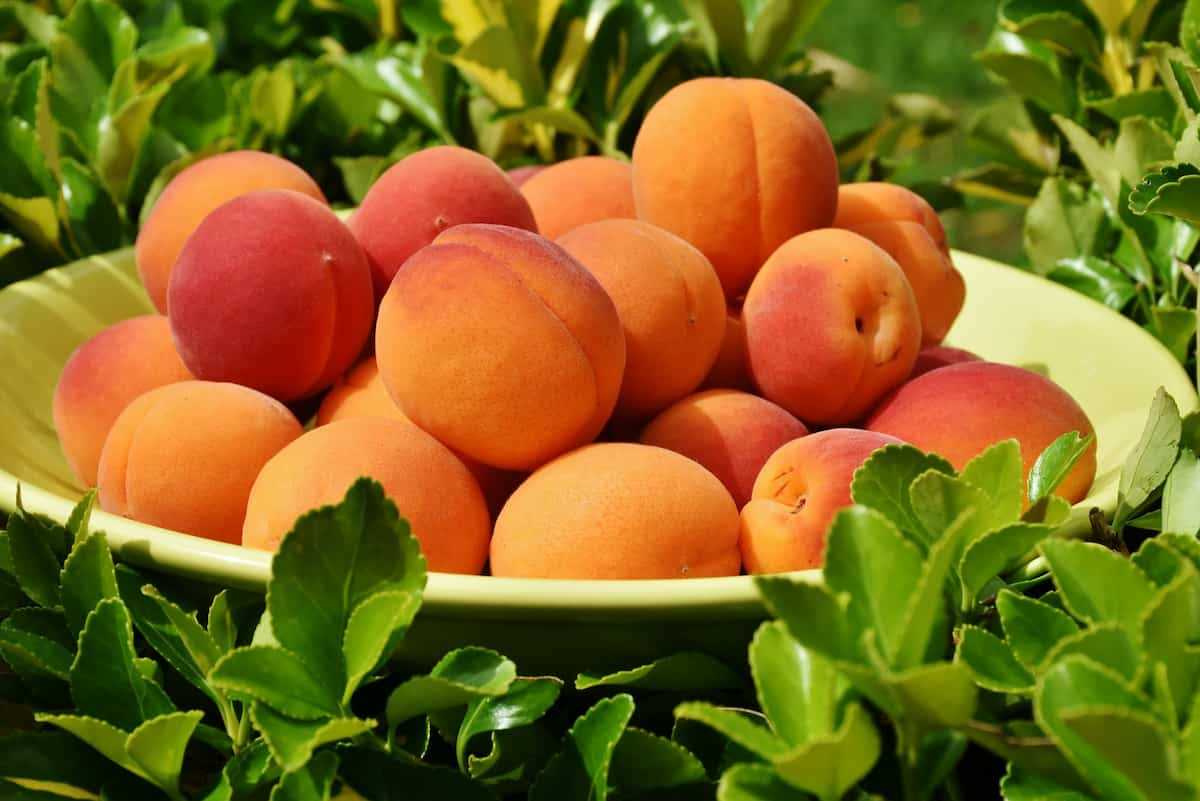

Take advantage of the summer grilling season by making a delicious grilled peach salad. Slice ripe peaches and grill them until they have beautiful char marks. Toss them with mixed greens, crumbled goat cheese, toasted pecans, and a simple balsamic vinaigrette. The combination of sweet and smoky flavors is simply irresistible.
Peach Salsa
Add a burst of freshness to your meals with homemade peach salsa. Dice ripe peaches and mix them with red onions, jalapenos, cilantro, lime juice, and a touch of salt. It’s a delightful accompaniment to grilled chicken, fish tacos, or simply enjoyed with crispy tortilla chips.
Peach Pie
No list of peach recipes would be complete without a classic peach pie. The flaky crust holds a luscious filling made with sliced peaches, sugar, a squeeze of lemon juice, and a sprinkle of cinnamon. Serve it warm with a dollop of whipped cream for a slice of heaven.
Conclusion
With these peach recipes, you can savor the incredible flavor of fresh peaches from your own harvest. From sweet desserts to savory dishes, peaches can be enjoyed in a variety of delicious ways. Get creative in the kitchen and explore new ways to showcase this versatile and delightful fruit.
Question-answer:
Can I grow peaches from seed?
Yes, you can grow peaches from seed. However, keep in mind that peaches grown from seed may not produce the same quality of fruit as the parent plant.
How long does it take for a peach tree to grow from seed?
It usually takes about 3-4 years for a peach tree to grow from seed and start producing fruit.
What is the best time to plant peach seeds?
The best time to plant peach seeds is in the spring, after the last frost. This will give the seeds enough time to germinate and grow into seedlings before the summer heat.
Do peach trees need a lot of sunlight?
Yes, peach trees need a lot of sunlight to grow and produce fruit. They should be planted in an area that receives at least 6-8 hours of direct sunlight per day.
How often should I water peach trees?
Peach trees should be watered regularly, especially during dry periods. They usually require about 1-2 inches of water per week. However, be careful not to overwater the trees as this can lead to root rot.
When is the best time to harvest peaches?
The best time to harvest peaches is when they are fully ripe and have a slightly soft texture. This usually occurs in the late summer to early fall, depending on the variety of peach.







